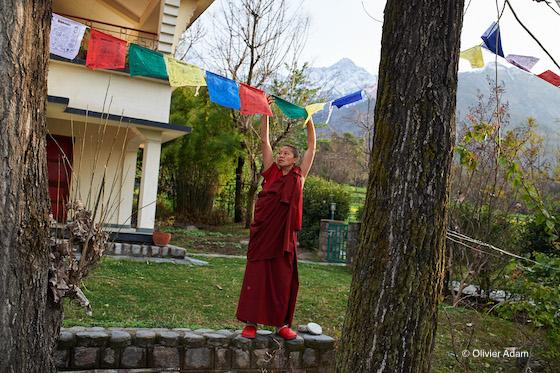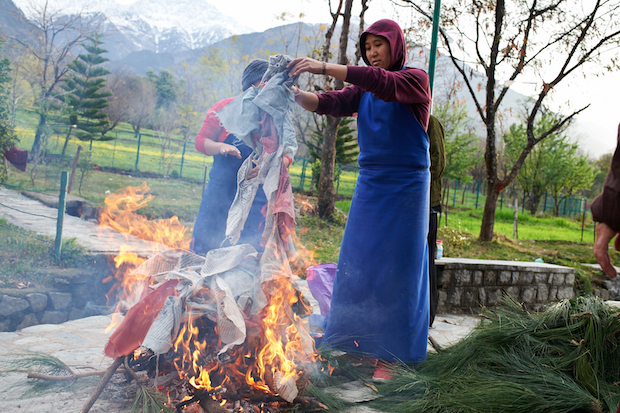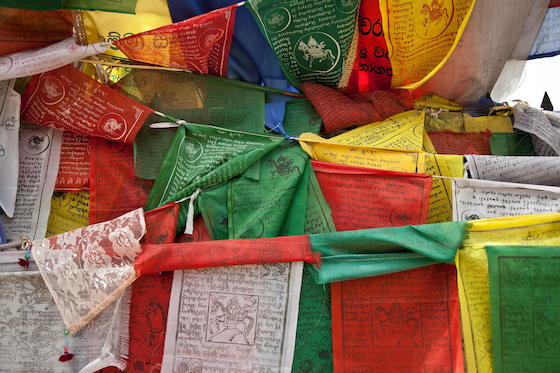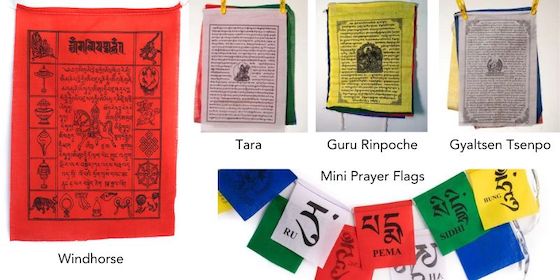Here are 5 things you might like to know about Tibetan prayer flags.
1. When you are hanging prayer flags have good intentions
When raising prayer flags it is important to have a good motivation. You should not have selfish or limiting thoughts. When hanging prayer flags, wish that all beings everywhere will benefit and find happiness.
Tibetan prayer flags are used to promote peace, compassion, strength, and wisdom. Tibetans believe the prayers and mantras printed on the flags will be spread by the wind and bring goodwill and compassion to benefit all beings.

Tibetan Windhorse or lung-ta prayer flags in the Himalayas. Prayer flags are hung to bring benefit to all beings.
2. Each of the 5 colors has a meaning
Tibetan prayer flags come in sets of five, with one flag in each of the five colors. The colors from left to right are in this specific order: blue, white, red, green, and yellow.
Each color represents an element.
- Blue symbolizes the sky and space.
- White symbolizes the air and wind.
- Red symbolizes fire.
- Green symbolizes water.
- Yellow symbolizes earth.

A Tibetan Buddhist nun hangs new prayer flags at Dolma Ling Nunnery and Institute. It is traditional to hang new prayer flags at Losar, the Tibetan New Year. Photo courtesy of Olivier Adam.
Some people have asked whether it is OK to disassemble sets of prayer flags and use them separately. It is better not to take apart the set of prayer flags. They represent the five elements in balance and it is not appropriate to the purpose or culture to separate them. Instead, you might choose to double them back or allow the remaining flags to hang down without touching the ground.
3. You should treat prayer flags with respect
Tibetans consider prayer flags to be holy. The flags contain sacred texts and symbols and should always be treated respectfully. They should not touch the ground or be put in the trash.
When disposing of old prayer flags, you should safely burn them so that the smoke may carry their blessings to the heavens. Again, do not let prayer flags touch the ground as they are burned.

A Tibetan Buddhist nun burns old prayer flags while being careful not to let them touch the ground. As she does this, she holds in her mind the wish to end the suffering of all sentient beings. Photo courtesy of Olivier Adam.
As you are burning the prayer flags, remember the intentions with which the prayer flags were made, blessed, and hung. You should have compassion for all sentient beings.
You may also choose to let your old Tibetan prayer flags fade and disintegrate. If you wish, you can hang new prayer flags together with old ones. The contrast between old and new is a reminder of impermanence and the continuing cycle of birth and death.

You can hang new prayer flags up with old prayer flags. The contrast between old and new is a reminder of impermanence and the continuing cycle of birth and death.
The traditional cotton prayer flags, like those made by the nuns at Dolma Ling and sold in the Tibetan Nuns Project online store, fade more quickly than synthetic ones and come on a cotton string. The fact that they do not last is part of their nature and is a reminder of the central Buddhist teaching of impermanence.
4. You don’t have to be a Buddhist to hang prayer flags
Some people have asked whether it is OK for non-Buddhists to display Tibetan prayer flags. Yes, it is fine. Again, your motivation and intentions are key. Hang them with a wish for all beings to be free of suffering and the causes of suffering, or for a positive intention of your choice.
5. There are different types and sizes of prayer flags
Prayer flags are made of block-printed fabric using traditional printing techniques going back hundreds of years. They come in various types and sizes.

Here are some of the types of Tibetan prayer flags sold in the Tibetan Nuns Project online store. They are made and blessed by the nuns at Dolma Ling Nunnery.
The most common types are square or rectangular and connected along their top edges to a long string. They are hung on a straight or diagonal line between two objects and in high places such as the tops of temples, monasteries, stupas, and mountain passes.
Another type of prayer flag is called Darchog. These vertical prayer flags are usually large single rectangles attached to poles along their vertical edge. Darchog are commonly planted in the ground, mountains, cairns, or on rooftops.
The Windhorse or Lung-ta is the most common type of prayer flag. In the center of each prayer flag is the symbol of a powerful horse (lung-ta in Tibetan) bearing three flaming jewels on its back. The triple gem or three jewels represent the Buddha, the dharma (the teachings), and the sangha (the community of practitioners).
The horse (ta in Tibetan) is a symbol of speed and the transformation of bad fortune to good fortune. Surrounding the lung-ta are mantras and Buddhist sacred symbols. In the corners of the prayer flags are images of four powerful animals, also known as the Four Dignities: the dragon, the garuda, the tiger, and the snow lion. You can purchase Windhorse prayer flags here.
Other types of Tibetan prayer flags made by the nuns and sold in our online store include:
- Tara prayer flags with a lovely image of Tara in the center. Tara represents virtuous and enlightened action. It is said that her compassion for living beings is stronger than a mother’s love for her children. She brings about longevity, protects travel, and guards her followers on their spiritual journey to enlightenment.
- Guru Rinpoche prayer flags. Padmasambhava, the renowned 8th-century saint, was a central figure in shaping Buddhism’s history in Tibet. Revered as the second Buddha, Guru Rinpoche (Precious Guru) conquered the local deities and demons of Tibet and bound them by oath to become guardians of Buddhism.
- Gyaltsen Tsenpo prayer flags are printed with sutras bestowed by Lord Buddha to Indra, king of the gods, to overcome his enemies and achieve victory. This is a common prayer flag, especially at New Year, symbolizing new ventures and beginnings.
- Mini prayer flags. These are perfect for small spaces, such as above your desk, computer or in your kitchen window. These prayer flags are handmade and blessed by Tibetan Buddhist nuns in India. There are four kinds with different mantras.

Thank you! I’ve had my prayer flags for a long time. I have 2 sets of Tibetan Prayer Flags. Now they are each hanging in one of my windows in my small home. I love them. They symbolize Peace, Love, and Service to me. Guideposts for my own life hopefully always.
This was so helpful! I worried that it was inappropriate for me, a non-Buddhist, to hang the prayer flags. I’ve always been drawn to them and now I know what the symbols mean. Thank you!
Can you hang indoors? In a bedroom?
Thank you 🙂
Yes, if you like, you can hang them indoors.
Yeah
One of the flags in my set (yellow) is torn from snagging on a branch. Can I still use them?
Yes, it can be a reminder of impermanence. Tibetan prayer flags can be left to fade and disintegrate naturally.
How hard must the prayer flags flap to bestow blessings? Is a slight breeze that just lifts and drops them enough?
Dear Christopher, Tibetans usually hang prayer flags in high places where the wind is stronger, but any breeze is fine. There is power in your intention and compassionate act of hoisting prayer flags and in your wish for all beings to be happy and to be free of suffering and the causes of suffering. Thank you!
Hi, I have noticed that most of tibetan stupas in Tibet & India didn’t hung pray flags on it where as in nepal they do. Why?
can we hung pray flag on the stupas?!
Regards
Anne Sophie.
Dear Anne, yes it’s not a Tibetan practice to hang prayer flags on stupas. In Nepal there is a mixture of cultures and it is more of a melting pot of traditions.
I live in a small hotel room but I have a set of prayer flags and I ride my bike every weekend. Would it be disrespectful to hang my flags on my bike to catch the wind while I ride?
That should be fine. It’s about intention and respect. In Dharamsala, one sometimes sees Tibetans with motorbikes with mini-prayer flags on them. 🙂
hola amigos..uno puede diseñar sus propias banderines con proposito para ser colgadas en el tibet? o esto seria una ofensa a su cultura?
Dear Zami, It looks as if you are asking, “Hello friends, can one design their own banners to be hung in Tibet? Or would this be an offense to their culture?” Tibetan prayer flags are powerful because of their prayers, sacred symbols, and the intention and motivation in hanging them. Homemade flags are not an offense, but would lack this rich and powerful meaning.